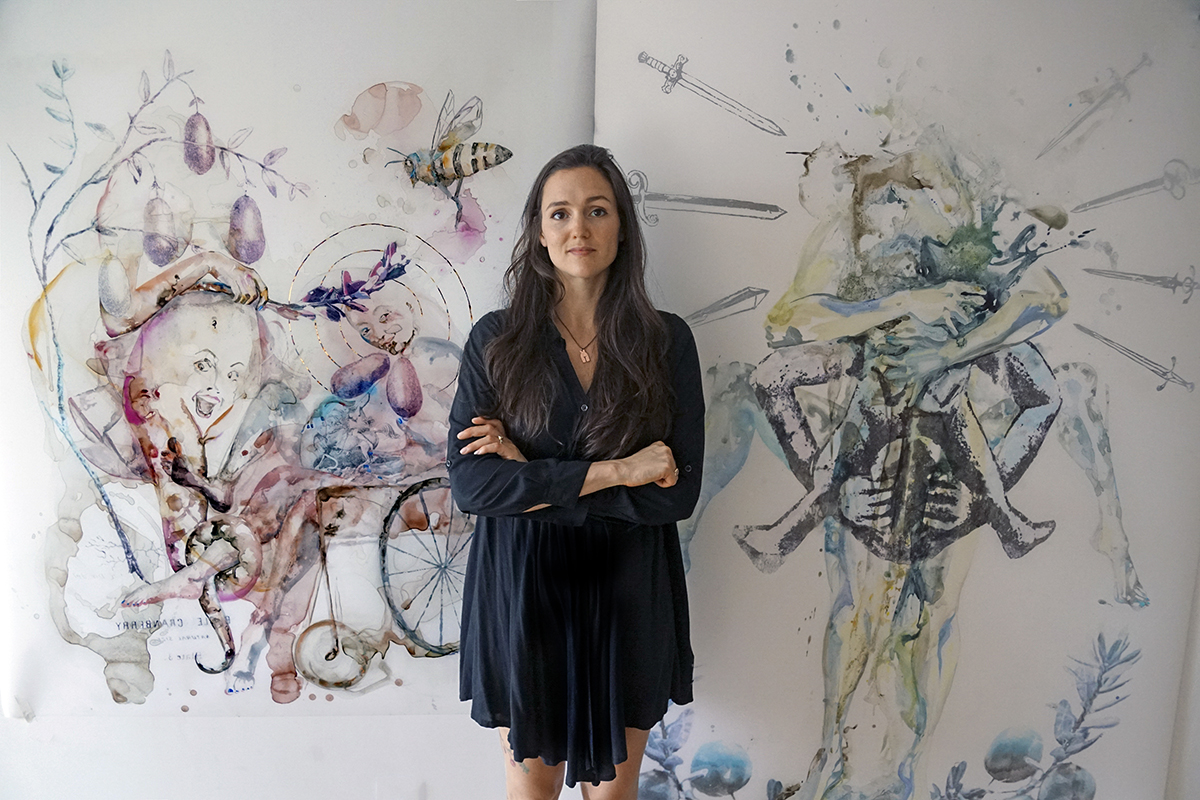It was the first time I started questioning my conceptual motivations and researching the content of my work."
Alexandra Carter

For visual artist Alexandra Carter ’04, the process of painting veers toward performance art. Before she picks up her brushes, Carter often acts out an image or tries to embody a word or idea that interests her. A fly on the wall of her Los Angeles studio might observe the artist wrapping herself in fish netting and trying to break free or pretending to be an animal crawling on the floor.
“I’ve always been interested in exploring the body,” says Carter, who earned her MFA in fine art from Goldsmiths, University of London, and has exhibited her work in major galleries across the globe. “My experience within [a body], one that is specifically female, how that body is used in images and as means for narrative, and where its physical and emotional boundaries [lie].”
Her solo “acts” in the studio are heavily influenced by her research into expressionist dance forms such as butoh, and she sees theater and all of its trappings as a natural part of her work: “When I depict costumes, they become an extension of the body, a way to exaggerate or emphasize a certain aspect of physical form.”
Referencing photographs of her body in motion — along with words and images she’s collected from other sources — Carter layers figures into her paintings to create a narrative that reveals itself only after she puts down her brushes. She credits Barbara Jenny, her art teacher at Exeter, for challenging her to uncover meaning in the images she was making. “It was the first time I started questioning my conceptual motivations and researching the content of my work,” she says.
Carter’s choice in media — typically Mylar drafting film — adds to the drama of her work. The paint she uses, primarily acrylic and dye-based inks, tends to puddle and bead on its surface, while the translucent nature of the film allows her to paint on both sides. Because her images can appear to change from different angles, the viewer is involved in constructing a story line along with her.
The idea of transformation is intriguing to Carter, as is her fascination with narratives of all kinds. “Abstract and minimal work never seemed to be an option for me,” she explains. “I needed more to hold onto. … I think it’s necessary to investigate the stories we grew up with, and other stories that have been told throughout history, and how those have shaped us. That’s why imagery from mythology, folklore and fairy tale have had such a presence in my work.”
The artist’s own story is rooted in her childhood on a cranberry farm in New England —so rooted, in fact, that she has taken to painting with cranberry juice. By using the actual fruit as her material, Carter incorporates sense memory into her process, evoking “the buzzing of machine engines during harvest … the pop of squishing berries under heavy rubber waders … and the sharp taste of a wet waxy cranberry,” in her words.
This cranberry-related imagery pays homage to Carter’s origins, but also expresses the tensions within. “The cranberry itself was a life force, the source of our financial stability, which, at the whim of crop turnouts, was volatile,” she says. “[But…] the fruit also brings along more visceral, feminine allusions to the body, with its redness and roundness.”
Carter is currently building a body of work that springs from these early memories while exploring the full range and reach of her human experience. Her most recent solo exhibition, “Berries for Baubo,” was on view at Los Angeles’ Radiant Space gallery in September.
— Genny Beckman Moriarty
Editor’s note: This article first appeared in the fall 2019 issue of The Exeter Bulletin.


